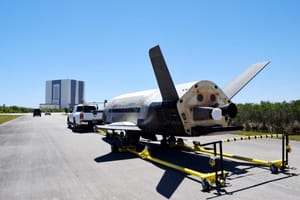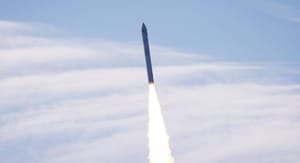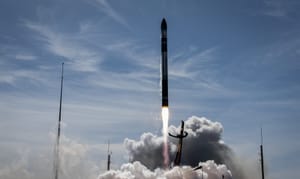
Nov 9, 2023
X-37B Jumpscare: Stealthy Spaceplane to Launch in Early December

UPDATE November 29th, 2023: Launch of OTV-7 has been pushed from December 7th to December 10th since publishing. This article has been edited to reflect this.
In a surprise to all but the most astute observers, Boeing's X-37B spaceplane is headed back to orbit next month. While its exact mission and orbital parameters are still classified, the US Air Force Rapid Capabilities Office, in partnership with the US Space Force, blew the lid Wednesday afternoon on the date of its next flight: December 10th, 2023.
X-37B has always been somewhat of an enigma; as for observable traits, it is about 5 metric tons, 9 meters long and with a 4.5 meter wingspan, and has a capable propulsion system paired with an expendable service module, much like Sierra Space's Dream Chaser. Many jokes have been cracked about the contents of its payload bay, as owing to its military nature it is shrouded in the utmost secrecy and tends to take people by surprise at both time of launch and time of landing (the latter of which is typically not even announced). Most speculated that OTV-7 would launch aboard USSF-51, a ULA Atlas V, and reach a Low Earth Orbit much like its predecessors.

But in fact, somewhat head-scratchingly, the chosen launch vehicle for this mission, USSF-52/OTV-7, is SpaceX's Falcon Heavy. This is FH's first time launching the spaceplane, and could very well be seen as overkill considering the previous six flights have taken place on ULA's Atlas V 501 and SpaceX's Falcon 9 Block 4. Once again, the precise destination and purpose of X-37B is highly classified, but it is anticipated to be targeting a higher Earth orbit than previous flights, but notably not a Geostationary orbit.
Considering the significant uptick in launcher capabilities, the vehicle itself has likely sustained significant upgrades adding to its launch mass, such as a beefed-up heat shield, a more capable service module (allowing for more substantial changes in orbit - key for a sneaky and agile military asset), and likely upgrades to its electronics to sustain the craft for longer in a more intense radiation environment.
The particular Falcon Heavy to launch this mission is comprised of an all-new center core, B1084, a pair of side boosters, B1064 and B1065, which have previously supported the USSF-44, USSF-67, EchoStar 24 (Jupiter 3) and Psyche missions, and a brand-new pair of fairings, in which the X-37B (the second of two vehicles in Boeing's fleet, aptly named Vehicle 2) was encapsulated several months ago.
While the exact launch time is not known, December 10th is going to be simultaneously quite exciting and highly confusing for all. Post-launch, amateur satellite-trackers are likely to pick up roughly where X-37B is headed, and this will help us formulate a guess as to what it's doing up there - but until then, it shall remain a mystery.



